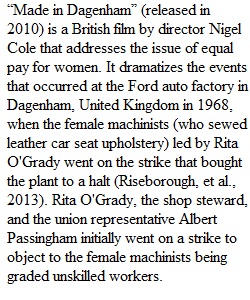


Q Applicable Learning Outcomes 1. Compare the key differences between union and non-union workplaces. 2. Differentiate between management, union and labour relations boards objectives, processes, and strategies. 6. Identify the causes and predict the consequences of strike or lockout activity • Description • In recognition of CapU's unique nature of a university that leads in the nation in the film industry, this is a new assessment I have designed to bring the cinematic culture into the business classroom. • For the report, you will be provided with inquiry-based questions that you will answer in your own words. • Watch the assigned film to think through the different strategies used by unions and management in situations where the Employer and Employees disagree on working conditions. • You are expected to consult at least three outside sources, which may include news sites, library databases, friends, family, or mentors. As always, you must cite these sources on your References page. Assigned films for BADM303-01 Spring 2022 Made in Dagenham (2010) https://ezproxy.capilanou.ca/login?url=https://search.ebscohost.com/login.aspx?direct=true&db=cat02755a&AN=cul.b949989&site=eds-live&scope=site • Cinematic Inquiry-Based Learning (10%)Assignment • After watching the assigned film for your course, answer the question prompts relevant to your level of study. Level of Study Questioning Prompts 100-level course • Give a brief (2-3 sentence) summary of the film • Identify and describe the main problem the protagonist deals with • Identify and describe the protagonist's plan(s) and attempts to solve the problem • Identify and describe the consequences of each plan and attempt to solve the problem • Identify and describe the ending of the film and tie it back to the problem you identified above 200-level course • All the questions above, plus… • What can you infer about the motivations behind the action of the main protagonists? • What are alternative conclusions one may have come to based on the evidence of the situation depicted? • What do you think might happen if a different strategy had been applied? • How would you have handled a comparable situation? Why? 300-level course • All the questions above, plus… • Describe and then explain the patterns of behaviour of managers and employees as depicted in the film. • What inconsistencies do you detect with the management/business scenario depicted in the film? • What other solutions to the problem should the protagonists have tried? What would you predict have been the result of these other choices? 400-level course • All the questions above, plus… • Name and describe the strategies the manager will need to use for the ongoing maintenance of the solutions implemented by the resolution of the film. • Considering how circumstances changed for the workers and managers by the end of the film, what do you theorize will be the long-term impacts on the careers of the protagonists? • Develop a set of criteria by which you can assess and evaluate the effectiveness of the choices made by the protagonists in the film and present your findings in a table. • Connect the circumstances of the movie to your own lived experiences and describe the similarities and differences. Then, develop an outline a proposal for how such circumstances could be avoided or better handled in your current workplace. • Rubric Not submitted or wholly insufficient Attempted, but inadequate Attempted Approaching expectations Almost meets expectations Meets expectations Exceeds expectations Outstanding First, answering the questions by demonstrating critical thinking skills appropriate to the level of the course 0 4 5 6 7 8 9 10 Next, expanding upon one's answers with thoughtful discussions and analyses 0 4 5 6 7 8 9 10 Then, linking to Required Readings and Resources, and 4th Hour Activities, plus Additional Research through Canadian Business & Current Affairs (CBCA) to defend analysis, discussions, and critical thinking 0 4 5 6 7 8 9 10 Finally, every answer is well-written in a professional style and tone using the AEC paragraph formula 0 4 5 6 7 8 9 10 The whole report follows APA 7th edition conventions for formatting, mechanics, file-naming, etc. 0 4 5 6 7 8 9 10 TOTAL = /50 •
View Related Questions